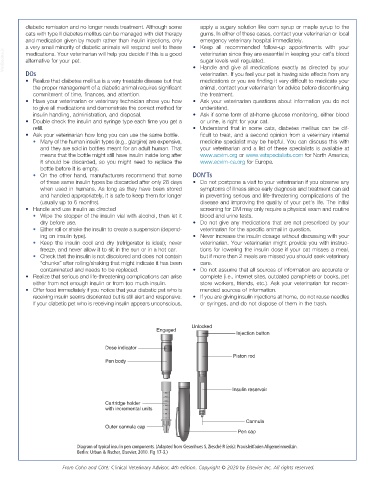Page 2976 - Cote clinical veterinary advisor dogs and cats 4th
P. 2976
diabetic remission and no longer needs treatment. Although some apply a sugary solution like corn syrup or maple syrup to the
cats with type II diabetes mellitus can be managed with diet therapy gums. In either of these cases, contact your veterinarian or local
and medication given by mouth rather than insulin injections, only emergency veterinary hospital immediately.
a very small minority of diabetic animals will respond well to these • Keep all recommended follow-up appointments with your
VetBooks.ir alternative for your pet. • Handle and give all medications exactly as directed by your
veterinarian since they are essential in keeping your cat’s blood
medications. Your veterinarian will help you decide if this is a good
sugar levels well regulated.
DOs veterinarian. If you feel your pet is having side effects from any
• Realize that diabetes mellitus is a very treatable disease but that medications or you are finding it very difficult to medicate your
the proper management of a diabetic animal requires significant animal, contact your veterinarian for advice before discontinuing
commitment of time, finances, and attention. the treatment.
• Have your veterinarian or veterinary technician show you how • Ask your veterinarian questions about information you do not
to give all medications and demonstrate the correct method for understand.
insulin handling, administration, and disposal. • Ask if some form of at-home glucose monitoring, either blood
• Double check the insulin and syringe type each time you get a or urine, is right for your cat.
refill. • Understand that in some cats, diabetes mellitus can be dif-
• Ask your veterinarian how long you can use the same bottle. ficult to treat, and a second opinion from a veterinary internal
• Many of the human insulin types (e.g., glargine) are expensive, medicine specialist may be helpful. You can discuss this with
and they are sold in bottles meant for an adult human. That your veterinarian and a list of these specialists is available at
means that the bottle might still have insulin inside long after www.acvim.org or www.vetspecialists.com for North America;
it should be discarded, so you might need to replace the www.ecvim-ca.org for Europe.
bottle before it is empty.
• On the other hand, manufacturers recommend that some DON’Ts
of these same insulin types be discarded after only 28 days • Do not postpone a visit to your veterinarian if you observe any
when used in humans. As long as they have been stored symptoms of illness since early diagnosis and treatment can aid
and handled appropriately, it is safe to keep them for longer in preventing serious and life-threatening complications of the
(usually up to 6 months). disease and improving the quality of your pet’s life. The initial
• Handle and use insulin as directed screening for DM may only require a physical exam and routine
• Wipe the stopper of the insulin vial with alcohol, then let it blood and urine tests.
dry before use. • Do not give any medications that are not prescribed by your
• Either roll or shake the insulin to create a suspension (depend- veterinarian for the specific animal in question.
ing on insulin type). • Never increase the insulin dosage without discussing with your
• Keep the insulin cool and dry (refrigerator is ideal); never veterinarian. Your veterinarian might provide you with instruc-
freeze, and never allow it to sit in the sun or in a hot car. tions for lowering the insulin dose if your cat misses a meal,
• Check that the insulin is not discolored and does not contain but if more than 2 meals are missed you should seek veterinary
“chunks” after rolling/shaking that might indicate it has been care.
contaminated and needs to be replaced. • Do not assume that all sources of information are accurate or
• Realize that serious and life-threatening complications can arise complete (i.e., internet sites, outdated pamphlets or books, pet
either from not enough insulin or from too much insulin. store workers, friends, etc.). Ask your veterinarian for recom-
• Offer food immediately if you notice that your diabetic pet who is mended sources of information.
receiving insulin seems disoriented but is still alert and responsive. • If you are giving insulin injections at home, do not reuse needles
If your diabetic pet who is receiving insulin appears unconscious, or syringes, and do not dispose of them in the trash.
Unlocked
Engaged
Injection button
Dose indicator
Piston rod
Pen body
Insulin reservoir
300
250
Cartridge holder 200
150
with incremental units 100
50
0
Cannula
Outer cannula cap
Pen cap
Diagram of typical insulin pen components. (Adapted from Gesenhues S, Ziesché R (eds): Praxisleitfaden Allgemeinmedizin.
Berlin: Urban & Fischer, Elsevier, 2010. Fig 17-3.)
From Cohn and Côté: Clinical Veterinary Advisor, 4th edition. Copyright © 2020 by Elsevier Inc. All rights reserved.

